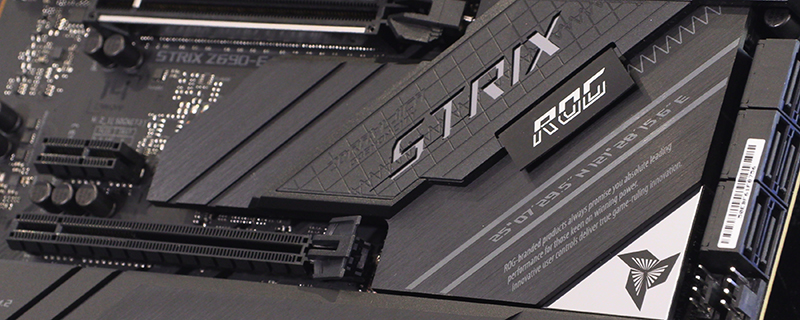ASUS ROG Strix Z690-E Gaming WiFi Review
Conclusion
Any time there is a new product launched the options available to you are usually split between a few at the bottom of the price range which give you the bare minimum, a few at the top end which break your wallet in two but give you everything it is possible to have, and then in the nice juicy middle the products which fit somewhere along the sliding scale in between those two extremes.
The ASUS Strix range has, since its inception, been a runaway success thanks to its positioning at the upper end of the middle section, giving you the majority of the elements you would like to have, some incredible aesthetics, but not quite tipping in to the serious chunk of change area of the price spectrum. Combine the brand recognition of the Republic of Gamers arm of ASUS, the reliability of the Strix name, and the flash and flair that normally accompanies the Strix range, and it shouldn’t surprise that their sales figures are off the charts.
The Z690-E is the newest addition to that famous range and has seen a little bit of a revision to the aesthetics in comparison to other Strix products we’ve seen recently. No longer does the box have the famous multi-hued ROG Eye that is so readily identifiable, instead the packaging is much more like one of the Maximus/Rampage ASUS models. The board itself has also dispenses with the glitchy font that plagued the last hardware set and, instead, has a much more toned down look than you might expect to find. The IO shield/VRM heatsink combo is all about the blue and purple. It’s still very purposeful though, with the M.2 slot just above the main PCI Express 5.0 slot has an extra heatpipe to really make certain that your M.2 drive can run flat out all the time without ever finding thermal throttling.
That ‘commitment to cool’ extends across the whole PCB. The VRM heatsink is amongst the chunkiest we’ve ever seen on a Strix motherboard and the chipset heatsink is equally substantial. Heck you can see from the full PCB width dual-M.2 heatspreader that it has a beefed up section in the middle, and that’s before we’ve got to the eight fan headers dotted around the motherboard giving you the best possible flexibility in fan placement and cable routing.
All of these small tweaks almost feels like the Strix has grown up a bit. The Z690-E is much less about flashy looks and dazzling light shows, and instead has toned things down a little to put a larger emphasis on performance. Performance which is right in the mix in our graphs, occasionally hitting the top as in Cinebench R23. Where it undoubtedly hits the top is in the efficiency of the design. Despite having an identical setup to our other Z690 tests the ASUS ROG Strix Z690-E Gaming WiFi has 33W less power draw at the wall than any other Z690 we’ve reviewed. This brings temperature benefits too, as our Core i9-12900K was 1°C at peak than any other board, whilst the VRM temperatures sat in second place at a lowly 52°C. Only the Maximus Hero was cooler.
The negatives are two-fold. Firstly, (at the time of writing) ASUS just will not tell us, or anyone, what lays beneath those VRM heatsinks. It’s not on the website, in the manual, in the press-pack. You have more chance discovering where the Templars hid the Holy Grail than you do discovering the power ampage of the Strix (we now know its 90a) . Secondly – and mainly- that price. The Z690-E Strix is currently £499.99. That puts it deep into the heart of the high end motherboards. The Maximus Hero, a significantly more appealing and better motherboard with beefier – and publically available – VRMs and all that goodness is £519.99. Not only do we recommend you get the Hero, we would suggest if you don’t get the Hero instead of the Strix then you have more money than sense. The Strix just finds itself in a very strange position where its trying to fight with its big brother and we have no idea why they have been put in the ring together.
Discuss the ASUS ROG Strix Z690-E Gaming WiFi on the OC3D Forums.



